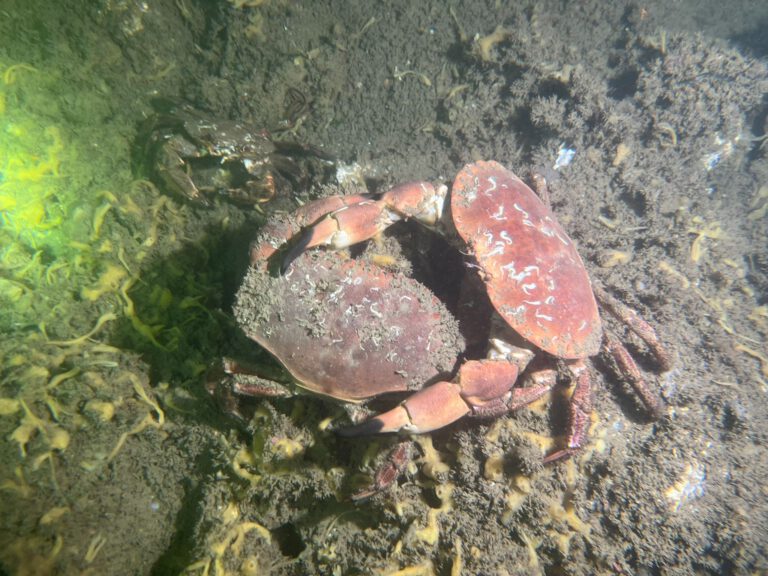Flounder (Platichthys flesus)

Flounder (Platichthys flesus) - Bot
- Taxonomy: The Flounder belongs to the Pleuronectidae family, which includes other flatfish species. The name Platichthys means “broad fish,” reflecting its flat body shape.
- Species: The European flounder is the most common in Zeeland waters. It can reach up to 50 cm in length and weigh around 2.7 kg.
- Reproduction: Flounders spawn in late winter and early spring. Females lay up to two million eggs, which float in open waters until hatching.
- Habitat: Flounders are found along coastal areas and estuaries. They prefer soft, sandy or muddy bottoms where they can bury themselves for camouflage.
- Diet: Carnivorous, feeding on small fish, worms, and crustaceans. They are bottom dwellers and use their flattened bodies to ambush prey.
- Conservation: Not considered endangered but face pressure from overfishing, habitat destruction, and pollution. There are ongoing efforts to manage and protect their populations.
- Unique Anatomy: Flounders undergo metamorphosis from a regular fish shape to a flat, asymmetrical body as they mature. One of their eyes migrates to the top side, allowing them to lay flat while keeping an eye on their surroundings.
- Color Change: Flounders have the remarkable ability to change their color to match the ocean floor, making them highly effective at hiding from predators.
- Lifespan: They can live up to 10 years in the wild, depending on environmental conditions and predation.
Flounders: Masters of Camouflage
When exploring the ocean floor, one of the most intriguing and well-hidden residents is the flounder. These flatfish are masters of disguise, blending in almost perfectly with the seabed. With their asymmetrical bodies and unique eye placement, flounders showcase one of the most interesting adaptations in marine life.
What is a Flounder?
Flounders, scientifically known as Platichthys flesus, are flatfish commonly found in the waters around Zeeland. Unlike many fish that swim upright, flounders spend their lives lying on one side of their body. This unusual shape helps them stay hidden from predators and sneak up on prey. One of the most fascinating aspects of their development is the migration of one eye to the top side as they mature, giving them a remarkable field of vision while lying flat on the ocean floor.
A Day in the Life of a Flounder
Flounders spend most of their time near the seabed, often burying themselves in sand or mud to avoid predators. They rely on stealth and patience to catch their prey, which includes small fish, worms, and crustaceans. Their ability to change color to match their surroundings further helps them remain undetected, making them efficient ambush predators.
Unique Adaptations: From Eyes to Skin
One of the most striking features of flounders is their ability to change color for camouflage. This adaptation not only aids in hunting but also helps them avoid being spotted by larger predators like seals and large fish. Their body is also built for life on the seafloor, with a flattened shape that allows them to stay close to the ground and remain hidden.
Flounder Reproduction: Life Begins in Open Water
Flounders spawn in open waters during late winter and early spring. Females can produce up to two million eggs, which float in the water column until they hatch. The juvenile flounders start life looking like typical fish, swimming upright. However, as they grow, their body transforms, and one eye shifts to the top side. By the time they reach adulthood, they have fully adapted to life as a flatfish, lying on the seafloor.
Ecological Role: Balancing the Food Chain
Flounders play a vital role in maintaining the balance of marine ecosystems. As bottom-dwellers, they help control populations of small invertebrates and fish. This, in turn, supports the overall health of estuary and coastal habitats where they reside. These areas are crucial nurseries for many marine species, making the flounder’s role essential in supporting biodiversity.
Threats and Conservation
Although flounders are not currently endangered, their populations face threats from overfishing, pollution, and habitat loss. Efforts are being made to monitor their populations and implement sustainable fishing practices to ensure their numbers remain stable.
Conclusion
The flounder may be one of the more overlooked fish in the sea, but its fascinating adaptations make it a remarkable species. From its ability to change color and blend into the seabed to its unique eye migration, the flounder is a true marvel of marine evolution. These fish not only captivate divers but also play a crucial role in maintaining the health of underwater ecosystems. By protecting their habitats, we ensure that future generations can continue to discover the wonders of these hidden masters of camouflage.







